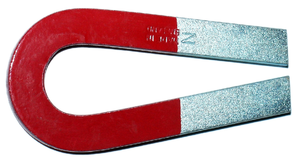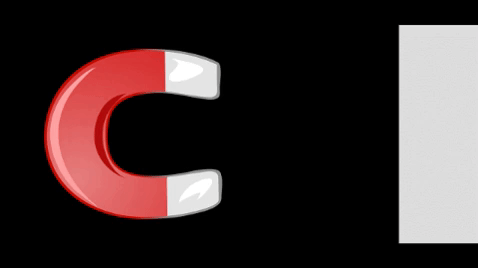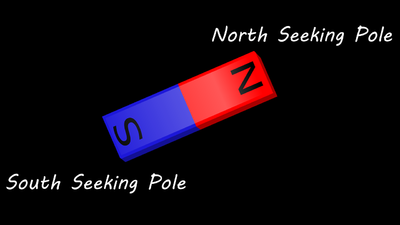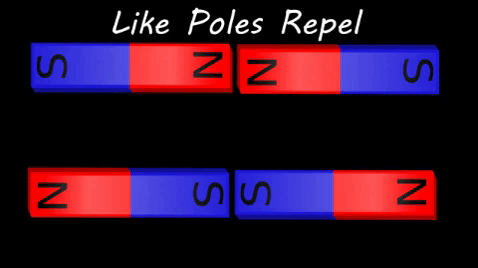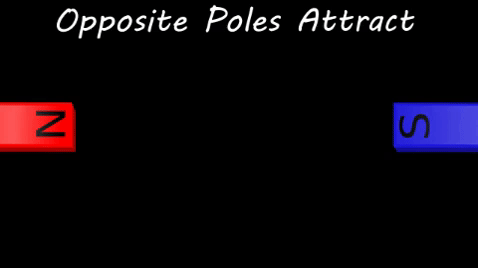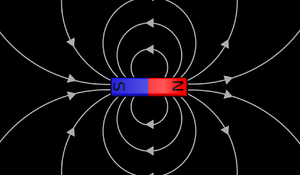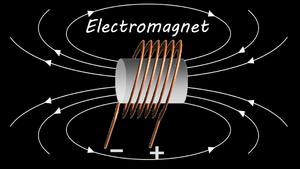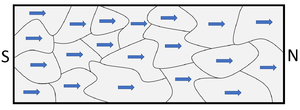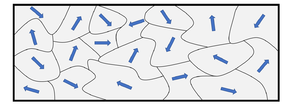Difference between revisions of "Magnet"
(→Key Stage 4) |
(→Key Stage 4) |
||
| Line 81: | Line 81: | ||
: The [[Earth]] is a [[magnet]] as evidenced by a [[Compass|magnetic compass]] lining up North to South everywhere on [[Earth]]. | : The [[Earth]] is a [[magnet]] as evidenced by a [[Compass|magnetic compass]] lining up North to South everywhere on [[Earth]]. | ||
: All [[magnet]]s have a [[Magnetic Field|magnetic field]] around them which influences other [[Magnetic Material|magnetic materials]]. | : All [[magnet]]s have a [[Magnetic Field|magnetic field]] around them which influences other [[Magnetic Material|magnetic materials]]. | ||
| + | : A [[magnet]] is made of several small [[Magnetic Domain|magnetic domains]] which are regions in the [[magnet]] which act as smaller [[magnet]]s. | ||
| + | |||
| + | {| class="wikitable" | ||
| + | |- | ||
| + | |[[File:MagneticDomainsAligned.png|center|300px]] | ||
| + | |[[File:MagneticDomainsUnaligned.png|center|300px]] | ||
| + | |- | ||
| + | | style="height:20px; width:200px; text-align:center;" |When [[Magnetic Domain|magnetic domains]] are aligned the [[object]] has an external [[Magnetic Field|magnetic field]] so it acts like a [[magnet]]. | ||
| + | | style="height:20px; width:200px; text-align:center;" |When the [[Magnetic Domain|magnetic domains]] are not aligned there is no external [[Magnetic Field|magnetic field]] because the effect of the [[Magnetic Domain|magnetic domains]] cancels out. | ||
| + | |} | ||
| + | |||
===Examples=== | ===Examples=== | ||
Revision as of 10:15, 4 March 2019
Contents
Key Stage 1
Meaning
A magnet is an object that sticks to some metals.
About Magnets
- Magnets are very useful. We can use them to stick notes to the fridge.
Key Stage 2
Meaning
A magnet is a piece of equipment that can be used to do determine if a material is magnetic.
About Magnets
- Magnets are attracted to some metals. Those metals are magnetic but they are not magnets themselves.
- Magnets have two poles; North and South.
- When two North Poles are placed next to each other two magnets will repel each other.
- When two South Poles are placed next to each other two magnets will repel each other.
- When the North Pole of one magnet is placed next to the South Pole of another magnet they attract each other.
Examples
| Magnets are attracted to some metals. Those metals are magnetic but they are not magnets themselves. | Magnets have two poles; North and South. |
| Two magnets facing North-North will repel each other and two magnets facing South-South will repel each other. | Two magnets facing North-South will attract each other. |
Key Stage 3
Meaning
A magnet is an object that attracts Iron, Cobalt or Nickel.
About Magnets
- There are three types of magnet you should know:
- Permanent Magnets - These are magnets which have a permanent magnetic field which needs energy to be removed.
- Induced Magnets - These are magnetic materials which only become magnets when they are in the magnetic field of another magnet.
- Electromagnets - These are a coil of wire wrapped around a soft iron core. They only become magnets when there is a current passed through the coil of wire.
- Magnets are attracted to some metals (Cobalt, Nickel and Iron). Those metals are magnetic but they are not magnets themselves.
- Magnets have two poles; North and South.
- When two North Poles are placed next to each other two magnets will repel each other.
- When two South Poles are placed next to each other two magnets will repel each other.
- When the North Pole of one magnet is placed next to the South Pole of another magnet they attract each other.
- All magnets have a magnetic field around them which influences other magnetic materials.
Examples
| The bar magnet is a permanent magnet. | This is a diagram of an electromagnet. |
Key Stage 4
Meaning
A magnet is an object that produces its own magnetic field.
About Magnets
- There are three types of magnet you should know:
- Permanent Magnets - These are magnets which have a permanent magnetic field which needs energy to be removed.
- Induced Magnets - These are magnetic materials which only become magnets when they are in the magnetic field of another magnet.
- Electromagnets - These are a coil of wire wrapped around a soft iron core. They only become magnets when there is a current passed through the coil of wire.
- Magnets are attracted to some metals (Cobalt, Nickel and Iron). Those metals are magnetic but they are not magnets themselves.
- Magnets have two poles; North and South.
- When two North Poles are placed next to each other two magnets will repel each other.
- When two South Poles are placed next to each other two magnets will repel each other.
- When the North Pole of one magnet is placed next to the South Pole of another magnet they attract each other.
- The Earth is a magnet as evidenced by a magnetic compass lining up North to South everywhere on Earth.
- All magnets have a magnetic field around them which influences other magnetic materials.
- A magnet is made of several small magnetic domains which are regions in the magnet which act as smaller magnets.
| When magnetic domains are aligned the object has an external magnetic field so it acts like a magnet. | When the magnetic domains are not aligned there is no external magnetic field because the effect of the magnetic domains cancels out. |
Examples
| The bar magnet is a permanent magnet. | This is a diagram of an electromagnet. |
